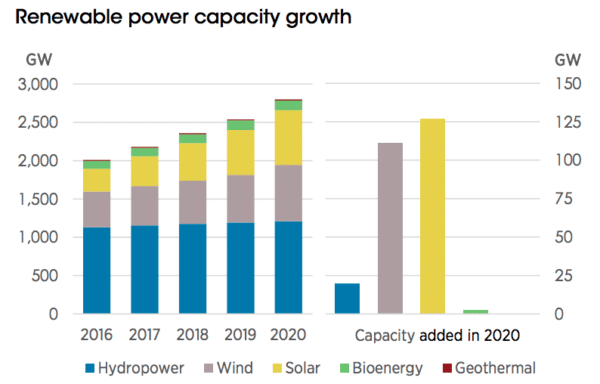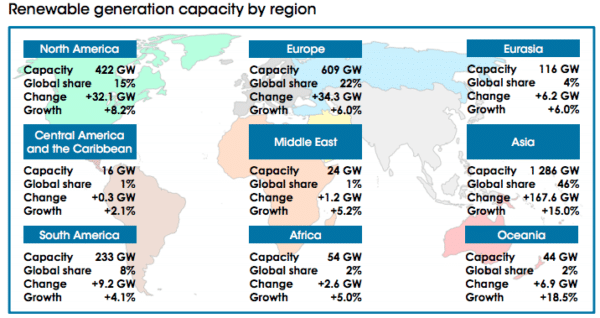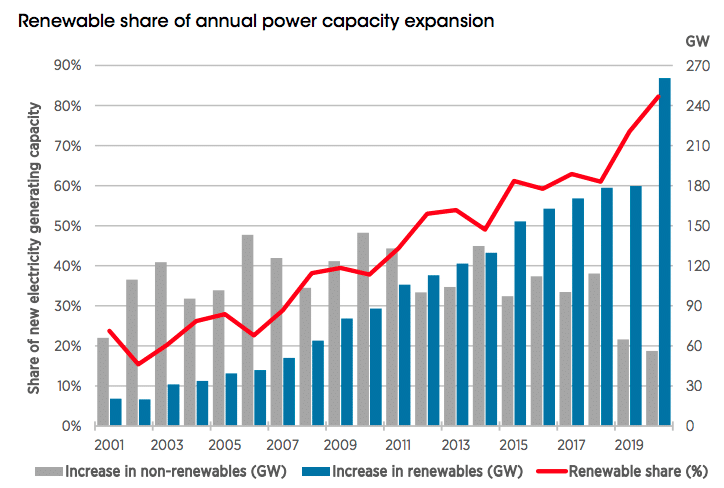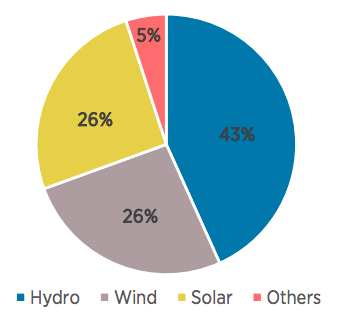In 2020, total global renewable capacity grew by 10.3%, representing an expansion the International Renewable Energy Agency (IRENA) described as “far more than in recent years and well above the longterm trend.”
The impressive growth was deemed even more remarkable for unfolding on the backdrop of a global pandemic, with IRENA’s Director-General, Francesco La Camera, hailing it as the start of the “decade of renewables.” Tellingly, more than 80% of all new electricity capacity added last year was renewable, with solar and wind accounting for 91% of that expansion.
“Along with the renewed growth of hydropower, this exceptional growth in wind and solar led to the highest annual increase in renewable generating capacity ever seen,” IRENA’s annual report, Renewable Capacity Statistics 2021 said.

This growth also meant renewables now account for a significantly higher share of the total new electricity capacity, increasing to 82% in 2020 compared to 73% in 2019.
At the end of 2020, global renewable generation capacity amounted to 2,799 GW with hydropower still accounting for the largest share of the global total, at 1,211 GW. Wind and solar energy accounted for equal shares of the remainder, with total capacities of 733 GW and 714 GW respectively.
Australia’s growth rate outstrips global trend
Oceania continued to be the fastest growing region, increasing its renewable generation capacity by 18.4%, growing at triple the rate of Europe (6%) and more than double that of North America (8.2%). “Almost all expansion occurred in Australia,” the report found.
The agency went on to note that despite its world-leading growth rate, Oceania’s global capacity remained small, accounting for just 2% of the total global share.

Renewable capacity growth in other global regions
Most of the world’s renewable capacity expansion occurred in China, and to a lesser extent, the United States, IRENA found. “Most other countries continued to increase renewable capacity at a similar rate to previous years,” the report finds.
Asia accounted for 64% of new capacity in 2020, increasing its renewable capacity by 167.6 GW to reach 1.29 TW, amounting to 46% of the global total. “A huge part of this increase occurred in China.”
Capacity in North America expanded by 32 GW, representing an 8.2% increase which mostly occurred in the US.
Europe expanded by 34 GW, a 6.0% increase, and Africa continued its steady trajectory with an increase of 2.6 GW, amounting to 5.0% which was slightly more than in 2019.
Rise of renewables coincides with the fall of previous empires
IRENA notes its findings reflect not only the rapid growth of renewables but also the simultaneous decline of non-renewable capacity.
Net decommissioning of fossil fuel generators continued in Europe, North America and, for the first time, Eurasia – the region including Armenia, Azerbaijan, Georgia, Russian Federation and Turkey.
New fossil fuel additions fell to 60 GW in 2020 from 64 GW the previous year, continuing their downward trend.
Highlights by renewable technology
- Hydropower continues to account for the largest share of global renewable capacity (1,211 GW), with almost double the total share of wind and solar (733 GW and 714 GW respectively). That being said, the growth of wind and solar far outstripped that of hydropower, which grew just 2% while solar grew at a rate of 22% and wind at 18%. For example, China added just 12 GW of hydropower capacity in 2020, compared to 49 GW of solar and 72 GW of new wind capacity.
- Solar expanded the most of all the renewable capacities, increasing by 127 GW. This level of expansion now has solar catching up to wind, IRENA found. This is largely thanks to massive expansions in Asia, which added 78 GW in 2020. Aside from the powerhouse that is China, Vietnam added 11 GW and Japan added over 5 GW. India and Republic of Korea both expanded solar capacity by more than 4 GW. The United States added 15 GW.
- Wind expansion almost doubled in 2020 compared to 2019, with 111 GW added last year, up from 58 GW the year before. China again led the charge, adding 72 GW of new capacity, followed by the United States which added 14 GW.
- Bioenergy’s expansion, on the other hand, halved in 2020, falling to 2.5 GW compared to 6.4 GW in 2019. The only two regions where bioenergy (largely gas) saw significant expansions were China, which added 2 GW, and Europe, which added 1.2 GW – similar to its additions in 2019.
“Remarkable story of resilience and hope”
“Despite the challenges and the uncertainty of 2020, renewable energy emerged as a source of undeniable optimism for a better, more equitable, resilient, clean and just future,” IRENA’s Director-General Francesco La Camera said. “The great reset offered a moment of reflection and chance to align our trajectory with the path to inclusive prosperity, and there are signs we are grasping it.
“These numbers tell a remarkable story of resilience and hope.”
“Despite the difficult period, as we predicted, 2020 marks the start of the decade of renewables,” La Camera added. “Costs are falling, clean tech markets are growing and never before have the benefits of the energy transition been so clear. This trend is unstoppable, but as the review of our World Energy Transition Outlook highlights, there is a huge amount to be done. Our 1.5 degree outlook shows significant planned energy investments must be redirected to support the transition if we are to achieve 2050 goals. In this critical decade of action, the international community must look to this trend as a source of inspiration to go further.”
This content is protected by copyright and may not be reused. If you want to cooperate with us and would like to reuse some of our content, please contact: editors@pv-magazine.com.










4 comments
By submitting this form you agree to pv magazine using your data for the purposes of publishing your comment.
Your personal data will only be disclosed or otherwise transmitted to third parties for the purposes of spam filtering or if this is necessary for technical maintenance of the website. Any other transfer to third parties will not take place unless this is justified on the basis of applicable data protection regulations or if pv magazine is legally obliged to do so.
You may revoke this consent at any time with effect for the future, in which case your personal data will be deleted immediately. Otherwise, your data will be deleted if pv magazine has processed your request or the purpose of data storage is fulfilled.
Further information on data privacy can be found in our Data Protection Policy.